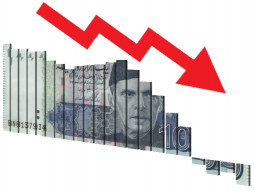
With default and debt restructuring on the cards, Fitch Ratings has downgraded Pakistan’s long-term foreign-currency issuer default rating (IDR) to ‘CCC-’ from ‘CCC+’ due to an alarming decline in foreign exchange reserves and the tough conditions set by the International Monetary Fund (IMF) in the run-up to elections in 2023.
The newly assigned rating of ‘CCC-’ suggests that the country is managing a high risk of default on its foreign debt, with there being low chances to escape default in the near future.
The latest downgrading reflects further deterioration in the country’s external liquidity and funding conditions, along with its low foreign exchange (FX) reserves. At the same time, however, the global rating agency strongly expects that the IMF shall resume its loan programme upon the completion of the ongoing talks with the country’s high officials.
“While we assume a successful conclusion of the ninth review of Pakistan’s IMF programme, the downgrade also reflects large risks to continued programme performance and funding, including in the run-up to this year’s elections. Default or debt restructuring is an increasingly real possibility, in our view,” said the New York-based agency and one of the three major global rating agencies.
The global rating agency cut the ratings amid uncertainty over the exact timing of resumption of the loan programme, as the country is due to repay $7 billion in the last four-and-half-months of the current fiscal year 2023, while its reserves have depleted to less than a three-week import cover at $2.9 billion at present.
“There is no outlook assigned, as Fitch typically does not assign outlooks to ratings of ‘CCC+’ or below,” the agency said in the commentary on its rating action on Tuesday. The country’s foreign exchange reserves have depleted to current critical levels from a peak of more than $20 billion in August 2021.
“Falling reserves reflect large, albeit declining, current account deficits (CADs), external debt servicing and earlier FX intervention by the central bank, particularly in the fourth quarter (October-December) of 2022, when an informal exchange-rate cap appears to have been in place. We expect reserves to remain at low levels, though we do forecast a modest recovery during the remainder of FY23, due to anticipated inflows and the recent removal of the exchange rate cap,” the agency added.
In addition to the remaining IMF disbursements of $2.5 billion, Pakistan stands to receive $3.5 billion from other multilateral creditors in FY23 after agreement with the IMF is reached.
“There have been reports of over $5 billion in additional commitments being considered by allies, on top of rollovers of existing funding, although details on the size and conditions are still pending. Pakistan received $10 billion in pledges at a flood-relief conference in January 2023, mostly in the form of loans,” Fitch said.
“The IMF’s conditions are likely to prove socially and politically difficult amid a sharp economic slowdown, high inflation and the devastation wrought by widespread floods last year. Elections are due by October 2023 and former prime minister Imran Khan, whose party will challenge the incumbent government in the elections, earlier rejected an invitation by Prime Minister Shehbhaz Sharif to hold talks on national issues, including IMF negotiations,” it explained.
However, “the authorities appear close to agreement on the ninth programme review after the conclusion of the IMF’s staff visit to Pakistan on February 9 and have already taken action that should facilitate agreement. This includes an apparent removal of a cap on the rupee exchange rate in January. The prime minister has repeatedly expressed the intention to remain in the programme.”
Meanwhile, Pakistan’s current account deficit (CAD) stood at $3.7 billion in the first half of FY23, down from $9 billion in the same period last year. “As such, we forecast a full-year deficit of $4.7 billion (1.5% of GDP) in FY23 after $17 billion (4.6% of GDP) in FY22,” said the agency, adding that, “The narrowing of the CAD has been driven by restrictions on imports and FX availability, as well as by fiscal tightening, higher interest rates and measures to limit energy consumption,” it said.
Published in The Express Tribune, February 15th, 2023.
Like Business on Facebook, follow @TribuneBiz on Twitter to stay informed and join in the conversation.





















COMMENTS (1)
Comments are moderated and generally will be posted if they are on-topic and not abusive.
For more information, please see our Comments FAQ